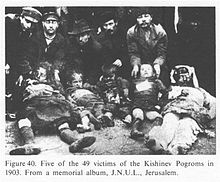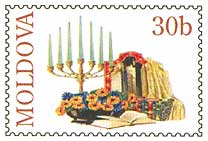History of the Jews in Bessarabia
The history of the Jews in Bessarabia, a historical region in Eastern Europe, dates back hundreds of years.
Early history

Jews are mentioned from very early on in the
Several times, when Jewish merchants created monopolies in some places in north Moldavia, Moldavian rulers sent them back to
In the 18th century, more Jews started to settle in Moldavia. Some of them were in charge of the Dniester crossings, replacing Moldavians and Greeks, until the captain of Soroca demanded their expulsion.
Others traded with
When this war ended, in 1812, Bessarabia (eastern half of the
Governorate of Bessarabia (1812–1917)
This section needs additional citations for verification. (August 2017) |
Status
The 1818 Statutory Law (Aşezământul) of the Governorate of Bessarabia mentions Jews as a separate state (social class), which was further divided into merchants, tradesmen, and land-workers. Unlike the other states, Jews were not allowed to own agricultural land, with the exception of "empty lots only from the property of the state, for cultivation and for building factories". Jews were allowed to keep and control the sale of spirits on government and private manors, to hold "mills, velniţas, breweries, and similar holdings", but were explicitly disallowed to "rule over Christians". During the 1817 census, there were 3,826 Jewish families in Bessarabia (estimated at 19,000 people, or 4.2% of the total population).[1]
Rural colonies
Over the next generations, the Jewish population of
As a result, the merchant activity was not enough to sustain all Jews, which led the Tsarist authorities to create 17 Jewish agricultural colonies:

In Soroca County
- Dumbrăveni (now part of Vădeni commune)
- Brăciova (Bricevo, now Briceva, part of Târnovacommune in Dondușeni district)
- Mărculești (Starăuca/Starovka, for some period)
- Vârtojani (Vertiujeni, Șteap for some period)
- Lublin(later Nemirovka, now Nimereuca)
- Căprești
- Zguriţa
- Maramonovca
- Constantinovca
In Orhei County
- Șibca (now Șipca)
- Nicolaevca-Blagodaţi (now Neculăieuca)
- Teleneștii Noi
In Chișinău County
- Grătiești and Hulboaca under joint administration (both now part of Grătești commune within Rîșcani sector of Chișinău)
In Bălți County
- Alexăndreni (now part of Alexăndreni Commune in Sîngerei District)
- Valea lui Vlad (now part of DumbrăvițaCommune in Sîngerei District)
In Hotin County
- Lomacinţa (now in Dnistrovskyi Raion, Chernivtsi Oblast of Ukraine)
In Tighina County
- Romanăuţi (Romanovca) (now within city limits of Basarabeasca)
10,589 Jews were settled in these villages, forming 1,082 households. This plan was borrowed from the ideas of Emperor Joseph II of Austria in regard to
Late 19th and early 20th centuries

- 1889: There were 180,918 Jews of a total population of 1,628,867 in Bessarabia, or 11.11%
- 1897: The Jewish populationhad grown to 225,637 of a total of 1,936,392, or 11.65%
- 1903: Chișinău (then known as Kishinev), in Russian Bessarabia had a Jewish population of 50,000, or 46%, out of a total of approximately 110,000. Jewish life flourished with 16 Jewish schools and over 2,000 pupils in Chişinău alone.
Kishinev pogrom

16 February 1903:
In 1903, a
1917–1940
Moldavian Democratic Republic
In the Sfatul Țării, Bessarabian Jews were represented by:
- Chişinău
- Eugen Kenigschatz, 58, lawyer, Chişinău
- Samuel Lichtmann, 60, civil servant
- Moise Slutski, 62, physician, Chişinău
- Gutman Landau, 40, civil servant
- Mendel Steinberg
The former four abstained from vote for the Union of Bessarabia with Romania on April 9 [O.S. March 27] 1918, while the latter two were absent.
Greater Romania

This section needs expansion. You can help by adding to it. (December 2009) |
- 1920: The Jewish population had grown to approx. 267,000.
- 1930: Romanian census registers 270,000 Jews
The Holocaust
In 1941, the
- … With the risk of not being understood by some traditionalists which may be among you, I am in favour of the forced migration of the entire Jew element from Bessarabia and Bukovina, which must be thrown over the border. Also, I am in favor of the forced migration of the Ukrainian element, which does not belong here at this time. I don't care if we appear in history as barbarians. The Roman Empire has made a series of barbaric acts from a contemporary point of view and, still, was the greatest political settlement. There has never been a more suitable moment. If necessary, shoot with the machine gun. (This quote can be found in "The Stenograms of the Ministers' Council, Ion Antonescu's Government", vol. IV, July–September 1941 period, Bucharest, year 2000, page 57) (Stenogramele şedinţelor Consiliului de Miniştri, Guvernarea Ion Antonescu, vol. IV, perioada iulie-septembrie 1941, București, anul 2000, pagina 57).
The killing squads of
In
In June–July 1941, about 10,000 (mostly civilians) were killed during the military action in the region in 1941 by German Einzatsgruppe D units and on some occasions by some Romanian troops. In
From 1941 to 1942, 120,000 Jews from Bessarabia, all of Bukovina, and the Dorohoi county in Romania proper, were deported to ghettos and concentration camps in
The remainder of the 270,000 Jewish community of the region survived World War II. Mostly these were Bessarabian Jews who wisely retreated before the departure of the Soviet troops in mid-July 1941. However, the only good thing that can be said about their fate during 1941–1944 was that they survived, because the conditions under which they traveled to the interior of the USSR (e.g., to Uzbekistan) in the summer of 1941 and their conditions at their arrival were very bad. Around 15,000 Jews from
As a result of the departure of the
Present day


By the end of 1993, there were an estimated 15,000 Jews in the
Demographics
| Jews in Bessarabia | ||||||||||||
| County | 1817 census | 1856 census | 1897 census | 1930 census | 1941 census | 1942 | 1959 census | 1970 census | 1979 census | 1989 census | 2002, 2004 census | |
| Hotin County | N/A | N/A | c. 54,000 | 35,985 | N/A | N/A | N/A1 | N/A1 | N/A1 | N/A1 | N/A1 | Ukrainian part |
| N/A2 | N/A2 | N/A2 | N/A2 | 1072 | Moldovan part | |||||||
| Soroca County | N/A | N/A | c. 31,000 | 29,191 | N/A | N/A | N/A3 | N/A3 | N/A3 | N/A3 | 1243 | |
| Bălți County | N/A | N/A | c. 17,000 | 31,695 | N/A | N/A | N/A4 | N/A4 | N/A4 | N/A4 | 4594 | |
| Orhei County | N/A | N/A | c. 26,000 | ... | N/A | N/A | N/A5 | N/A5 | N/A5 | N/A5 | 975 | |
Lăpușna County |
N/A | N/A | c. 53,000 | ... | N/A | N/A | N/A6 | N/A6 | N/A6 | N/A6 | 2,7086 | |
| Tighina County | N/A | N/A | c. 16,000 | ... | N/A | N/A | N/A7 | N/A7 | N/A7 | N/A7 | 4377 | |
| Cahul County | N/A | N/A | c. 11,000 | 4,434 | N/A | N/A | N/A8 | N/A8 | N/A8 | N/A8 | 678 | |
| Ismail County | N/A | N/A | 6,306 | N/A | N/A | N/A9 | N/A9 | N/A9 | N/A9 | N/A9 | ||
| Cetatea Albă County | N/A | N/A | c. 11,000 | 11,390 | N/A | N/A | Ukrainian part | |||||
| N/A10 | N/A10 | N/A10 | N/A10 | 110 | Moldovan part | |||||||
| Total | 19,130 | 78,751 | 225,637[5] | ... | ... | ... | ... | ... | ... | ... | ... | |
1 4 districts of Chernivtsi Oblast of Ukraine
2 Briceni and Edineț Districts of Moldova
3
4
5
6
7
8
9 9 districts and 2 cities of
10 Ștefan Vodă District of Moldova
Sources:
- Recensământul General al Populaţiei României din 29 Decemvrie 1930. Vol. II: Neam, Limbă Maternă, Religie. București 1938.
- Moldovan Census (2004)
According to the 1930 Romanian Census, Jews were distributed in Bessarabia as follows:
- Edineţi-Sat, 398, other localities 5,614. Total: 35,985
- Târnova, 236, Ocnița-Gară, 200, other localities 5,171. Total: 29,191
- Alexandreni-Târg, 1,018, Cornești-Târg 338, Glodeni, 212, other localities 5,663. Total: 31,695
- Orhei County:
- Lăpușna County:
- Tighina County:
- Cahul County: Leova, 2,324, Cahul, 803, Baimaclia, 509, other localities 798. Total: 4,434
- Bolgrad, 1,215, Reni, 1,170, other localities 346. Total: 6,306
- Arciz, 342, Sărata, 316, other localities 2,528. Total: 11,390
According to the 2004 Census, there are 4,000 Jews in the Bessarabian part of Moldova (excluding
- 2,649 in Chişinău,
- 411 in Bălți,
- 385 in Tighina (Bender),
- 548 in other localities under Chişinău control, and
- 7 in suburbs of Tighina (Bender) under Tiraspol control.
There were also 867 Jews in Transnistria, including
See also
- Batushansky
- History of the Jews in Moldova
- History of the Jews in Bukovina
- Jewish Roots in Ukraine and Moldova
- Jewish agricultural colonies in the Russian Empire
- Diana Dumitru, Moldovan researcher of the Holocaust in Bessarabia
Further reading
- Solonari, Vladimir (September 2006). ""Model province": Explaining the Holocaust of Bessarabian and Bukovinian Jewry". S2CID 129413315.
- Weiner, Miriam; Ukrainian State Archives (in cooperation with); Moldovan National Archives (in cooperation with) (1999). Jewish Roots in Ukraine and Moldova: Pages from the Past and Archival Inventories. Secaucus, NJ: Miriam Weiner Routes to Roots Foundation. OCLC 607423469.
- Jews of Bessarabia on the Eve of the War (PDF). New York: William Morrow. 1993. ISBN 978-0-965-65080-9– via Atlas of the Holocaust, rev. ed. by Sir Martin Gilbert. Reprinted with permission from the publisher
- Massacres, Deportations, and Death Marches from Bessarabia, From July 1941 (PDF). New York: William Morrow. 1993. ISBN 978-0-965-65080-9– via Atlas of the Holocaust, rev. ed. by Sir Martin Gilbert. Reprinted with permission from the publisher
- Jews of Bessarabia on the Eve of the War (PDF). New York: William Morrow. 1993.
References
- ^ a b c Ion Nistor, Istoria Basarabiei, Cernăuţi, 1923, reprinted Chişinău, Cartea Moldovenească, 1991, pp. 201-02
- ^ a b Ion Nistor, pp. 208–10
- ^ "The Jewish Community of Kishinev". The Museum of the Jewish People at Beit Hatfutsot. Archived from the original on 24 June 2018. Retrieved 24 June 2018.
- ^ Maresal Ion Antonescu, worldwar2.ro; accessed 27 August 2017.
- ^ "Moldova". Jewish Virtual Library.
